Ames Manufacturing Company
Ames Manufacturing Company was a manufacturer of swords, tools, and cutlery in Chicopee, Massachusetts, as well as an iron and bronze foundry. They were a significant provider of side arms, swords, light artillery, and heavy ordnance for the Union in the American Civil War. They also cast several bronze statues, which can be found throughout New England.
Ames Manufacturing Company | |
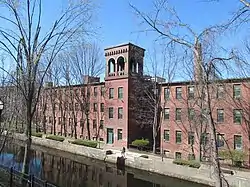 The former Ames factory in Chicopee, MA, now The Apartments at Ames Privilege | |
  | |
| Location | Chicopee, Massachusetts |
|---|---|
| Coordinates | 42°8′57″N 72°36′24″W |
| Built | 1847 |
| Architect | Charles McClallan |
| Architectural style | Early Republic, Greek Revival |
| NRHP reference No. | 83000734[1] |
| Added to NRHP | June 23, 1983 |
Company history
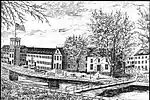
The Ames Manufacturing Company has its origins in a factory established in 1774 in Chelmsford, Massachusetts by the Ames family. Brothers Nathan P. Ames Jr. and James T. Ames moved their tool and cutlery business to a new industrial town on the Chicopee River near Springfield, Massachusetts in 1829.[2] They were invited by Edmund Dwight, who owned textile mills nearby.[3] The Ames company began manufacturing swords for the federal government and state militias.[4]
As the town of Chicopee was formed in 1848, the Ames brothers were leaders in the new community.[3] Upon the death of Nathan P. Ames in 1847, ownership of the company turned to younger brother James Tyler Ames.[5]
Iron and bronze foundries

By 1835, the company was creating works in brass and bronze, and in 1845, an iron foundry was added.[6] The company used the foundries for casting statuary and producing military cannons and cannonballs.[7]
The bronze doors of the East Wing of the United States Capitol and Daniel Chester French's Minuteman statue at the Lexington-Concord bridge were cast at the Ames company.[8] Other statues included large equestrian statues of George Washington (at the Boston Public Garden and in Washington, D.C.), a statue of Benjamin Franklin (Boston), and a statue of Major John Mason.[8]
When the Mexican–American War broke out, the foundry's primary output switched to armament.[7]
Civil War
Upon the declared secession and formation of the Confederate States of America, the United States Army lost access to its southern arsenals. Independent arms manufacturers became crucial to the success of the U.S. Army.[9] Ames was one of the U.S. Army's most important manufacturers of side arms, swords, and light artillery and the third largest producer of heavy ordnance.[9]
Post-war diversification and decline

In addition to producing military equipment for many years, including swords, cannons, and cannonballs, it produced sewing machine and bicycle parts in the later 19th century. The company was a major supplier of bicycles to the Overman Wheel Company from 1883-1887.[10] The sword manufacturing business was formally separated into an independent company in 1881.[11]
By 1907, the Ames foundries had been purchased by Chicopee's A.G. Spalding Company.[12]
Surviving buildings
The historic Ames Company factory, located at 5-7 Springfield Street in Chicopee, Massachusetts, is a complex of connected industrial buildings, the oldest of which dates to 1847. Most of the older elements are brick in construction and range in height from one to four stories. This complex was added to the National Register of Historic Places in 1983.[1] The largest surviving buildings have been converted into residences.
Gallery
- Past works of the Ames Manufacturing Company
 Sword and Scabbard of Captain Richard French, currently in display at the Metropolitan Museum of Art.
Sword and Scabbard of Captain Richard French, currently in display at the Metropolitan Museum of Art. The handle of Capt. French's sword.
The handle of Capt. French's sword. The sword was presented to Capt. French by the men of his company "LaFayette Fusiliers" on June 21, 1850.
The sword was presented to Capt. French by the men of his company "LaFayette Fusiliers" on June 21, 1850.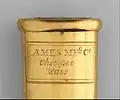 Ames Mfg Co. inscription on the Sword of Captain Richard French.
Ames Mfg Co. inscription on the Sword of Captain Richard French. Model 1832 Artillery Sword in display at the Concord Museum.
Model 1832 Artillery Sword in display at the Concord Museum.
- Notable works of the Ames Foundry
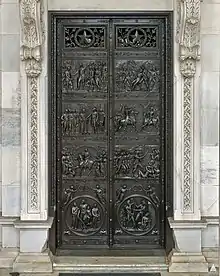 Ornate bronze doors on the east portico of the Senate wing were cast by James T. Ames in 1864–1868, and placed late in 1868.
Ornate bronze doors on the east portico of the Senate wing were cast by James T. Ames in 1864–1868, and placed late in 1868.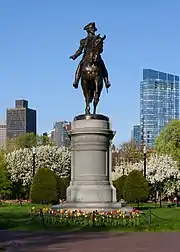
.jpg.webp) Foundry mark on the Equestrian statue of George Washington. (Boston Public Garden)
Foundry mark on the Equestrian statue of George Washington. (Boston Public Garden).jpg.webp) The Minute Man sculpture by Daniel Chester French was cast at Ames.
The Minute Man sculpture by Daniel Chester French was cast at Ames. Foundry mark on the Minuteman by Daniel Chester French, (Concord, Massachusetts)
Foundry mark on the Minuteman by Daniel Chester French, (Concord, Massachusetts)
See also
Notes
- NPS NRHP, Ames Manufacturing Company.
- Lynch (2006), p. 71.
- Lynch (2006), p. 71-73.
- Lynch (2006), p. 74; Flynt (2006), p. 1.
- Lynch (2006), p. 75.
- Lynch (2006), p. 72.
- Lynch (2006), p. 74.
- Lynch (2006), p. 77.
- Lynch (2006), p. 74-75.
- Jendrysik (2013).
- MACRIS Ames Manufacturing.
- Williams (1907), p. 227.
References
- Lynch, Jacqueline T. (June 2006). "Manufacturing a War: The Ames Company and Chicopee, Massachusetts". North & South. North & South Magazine, Inc. 9 (3): 70–79. ISSN 1522-9742. Retrieved 2023-02-17.
- "National Register of Historic Places Registration Form". MACRIS Massachusetts Cultural Resource Information System. Commonwealth of Massachusetts. 2000. Archived from the original on 2015-06-22. Retrieved 2015-09-21.
- "Digital Asset Management System". National Park Service.
- Jendrysik, Stephen (2013-06-26). "Stephen Jendrysik: Victor bicycle rode economic rise, fall". Masslive.com. Advance Local Media LLC. Retrieved 2016-02-26.
- Williams, David (1907-01-17). "New England Machinery Market" (pdf). The Iron Age. Reed Business Information. 79 (3): 227. ISSN 0164-5137. Retrieved 2016-02-26.
- Flynt, Sean A. (April 9, 2006). "Lost and Found: A U.S. Model 1860 Light Cavalry Saber". MyArmoury.com. <y Armoury. Retrieved 2007-10-05.
Further reading
- Lynch, Jacqueline T (2013). The Ames Manufacturing Company of Chicopee, Massachusetts: A Northern Factory Town's Perspective on the Civil War. CreateSpace Independent Publishing Platform. ISBN 978-1492700746.
External links
- Stearns-Ames collection, (ca. 1838-1894) in the Smithsonian Archives of American Art
